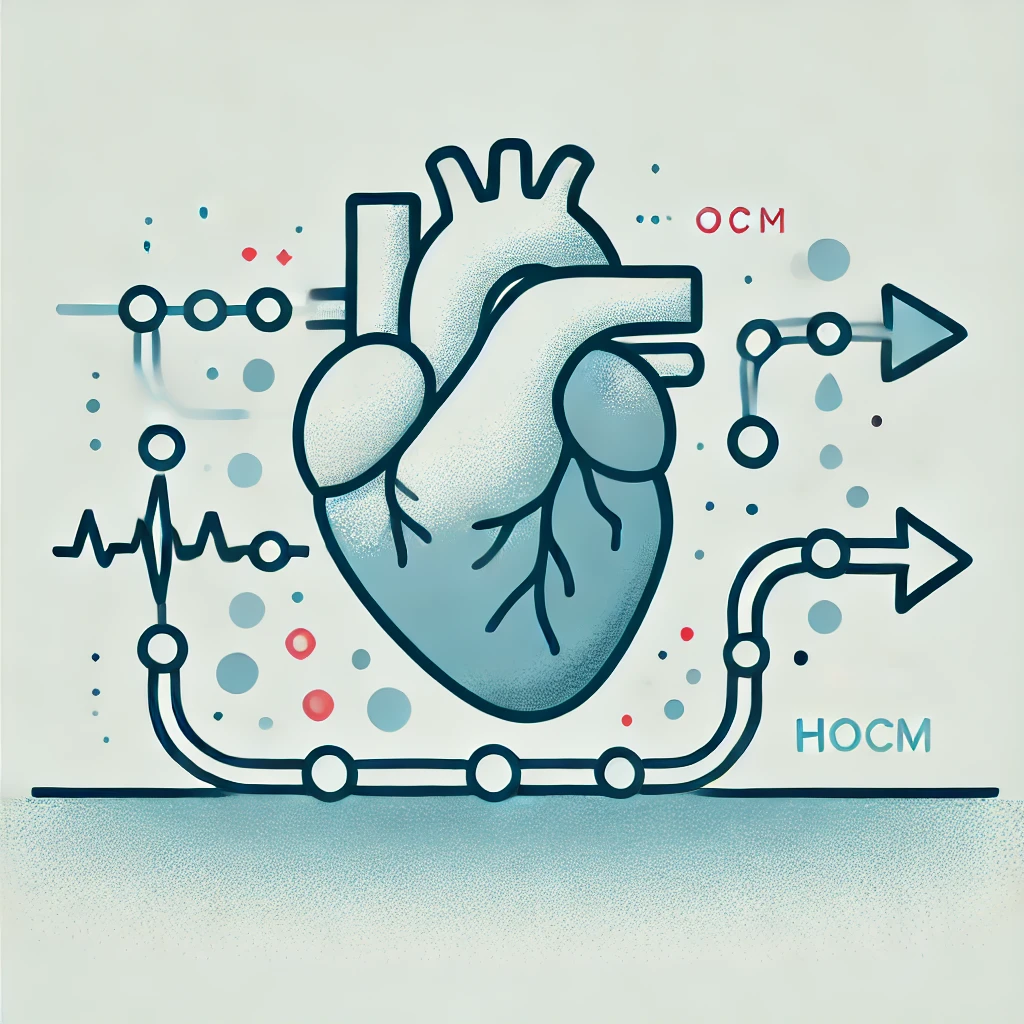Hypertrophic Obstructive Cardiomyopathy (HOCM) is a genetic disorder characterized by left ventricular hypertrophy (LVH) and dynamic outflow tract obstruction. It is a leading cause of sudden cardiac death (SCD) in young athletes due to arrhythmias and left ventricular outflow tract (LVOT) obstruction.
2. Causes and Pathophysiology
(A) Causes
- Genetic mutation (autosomal dominant) in sarcomere proteins:
- Beta-myosin heavy chain (MYH7)
- Myosin-binding protein C (MYBPC3)
- Family history of sudden cardiac death is a key risk factor.
(B) Pathophysiology
- Asymmetric septal hypertrophy → Left Ventricular Outflow Tract (LVOT) obstruction
- Diastolic dysfunction → Impaired ventricular filling → Increased left atrial pressure
- Mitral valve involvement → Systolic anterior motion (SAM) → Mitral regurgitation
- Arrhythmogenic potential → Increased risk of ventricular tachycardia (VT) and sudden cardiac death (SCD)
3. Clinical Features of HOCM
| Symptom/Sign | Clinical Features |
|---|---|
| Dyspnea | Due to diastolic dysfunction and increased filling pressures |
| Syncope | Exertional, due to LVOT obstruction or arrhythmias |
| Chest Pain (Angina) | Due to increased myocardial oxygen demand |
| Palpitations | Due to arrhythmias (AF, VT) |
| Sudden Cardiac Death (SCD) | Often in young athletes during exertion |
| Pulsus Bisferiens | Bifid pulse due to dynamic LVOT obstruction |
| Harsh systolic ejection murmur | Increases with Valsalva, decreases with squatting |
4. Diagnosis of HOCM
(A) Clinical Examination Findings
- Harsh crescendo-decrescendo murmur (mimics aortic stenosis)
- Increases with Valsalva/standing (↓ preload → worsens obstruction)
- Decreases with squatting/handgrip (↑ afterload → reduces obstruction)
(B) Investigations
| Test | Findings |
|---|---|
| ECG | Left ventricular hypertrophy (LVH), deep T wave inversions, dagger-like Q waves |
| Echocardiography (TTE) | Asymmetric septal hypertrophy, LVOT obstruction, Systolic Anterior Motion (SAM) of mitral valve |
| Cardiac MRI | Defines myocardial fibrosis |
| Holter Monitoring | Detects arrhythmias (AF, VT, NSVT) |
| Exercise Stress Testing | Assesses risk of SCD |
| Genetic Testing | MYH7, MYBPC3 mutations |
🔹 Echocardiography is the gold standard for diagnosis.
🔹 ECG may be abnormal even before hypertrophy is detected on echo.
5. Management of HOCM
(A) Medical Management
| Drug | Mechanism | Indication |
|---|---|---|
| Beta-blockers (e.g., Metoprolol, Bisoprolol) | ↓ HR, prolongs diastole | First-line for symptomatic patients |
| Calcium channel blockers (e.g., Verapamil) | Negative inotropy, reduces LVOT obstruction | If beta-blockers are contraindicated |
| Disopyramide | Negative inotropy, reduces obstruction | Adjunctive therapy |
| Anticoagulation (Warfarin, DOACs) | Prevents stroke in AF | If atrial fibrillation is present |
🔹 Avoid inotropes (digoxin), nitrates, and diuretics (they worsen obstruction).
(B) Interventional Management
| Procedure | Indication |
|---|---|
| Septal Myectomy | Severe symptoms despite medical therapy |
| Alcohol Septal Ablation | Alternative to myectomy (induces controlled infarction of hypertrophied septum) |
| Implantable Cardioverter Defibrillator (ICD) | High-risk patients for SCD prevention |
(C) Lifestyle Modifications & Activity Restrictions
- Avoid high-intensity sports (risk of sudden cardiac death)
- Encourage moderate activity (walking, swimming)
- Family screening (First-degree relatives should undergo echocardiography and genetic testing)
6. Risk of Sudden Cardiac Death (SCD) in HOCM
High-risk features:
🚨 History of syncope
🚨 Family history of SCD
🚨 Massive LV hypertrophy (≥30 mm)
🚨 Non-sustained ventricular tachycardia (NSVT) on Holter monitoring
🚨 Abnormal blood pressure response to exercise
SCD Prevention
- ICD implantation in high-risk individuals
- Beta-blockers and lifestyle modifications
7. Key Takeaways
✅ HOCM is a genetic disorder causing LV hypertrophy and LVOT obstruction.
✅ Symptoms include exertional syncope, dyspnea, and sudden cardiac death risk.
✅ Murmur increases with Valsalva and decreases with squatting.
✅ Beta-blockers are first-line therapy; avoid diuretics and inotropes.
✅ ICD implantation is crucial for high-risk patients.
Further Reading
- NHS Overview of Cardiomyopathy: NHS UK
- European Society of Cardiology (ESC) Guidelines: ESC Guidelines

